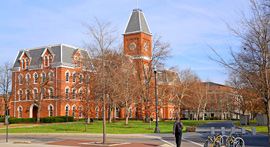Academics
It should come as no surprise that a United States Naval Academy education is all about “developing leaders” and fostering “a strong sense of honor and morals.” The school— which is free to attend—is certainly successful in this mission. As one midshipman explains, “I seldom hear of a graduate that, following their naval service, does not excel in the civilian workforce and successfully lead their teams to excellence.” An obvious explanation for this is in the way students are surrounded by “excellent people who genuinely care about your development” as well as “extensive study abroad opportunities and internships, relevant and respected guest speakers…hands-on learning on ships and other military platforms, [and] trips to nearby museums or other relevant locations.” Additionally, as you’d expect given the military component, “many classes go beyond the normal style of lectures. For example, seamanship classes can involve piloting actual watercraft at sea.”
Students find that their coursework is generally “challenging but definitely doable…You can tell that there are so many people that want to help you succeed.” Midshipmen also happily report that their “professors are very knowledgeable and easy to learn from” and make themselves “always available for meetings and extra instruction,” including their own—some note that “super open and extremely receptive to feedback on teaching style.” In all, “My overall academic experience has been extremely positive and worthwhile due to a great work environment.”
Student Body
Without question, the Naval Academy seems to attract individuals who are “extremely driven, capable, and intelligent.” As one student puts it, “Everyone here is the best where they come from and so it’s a school full of academic and physical studs.” Given the Academy’s demanding nature, it’s common for midshipmen to develop “strong bonds with one another.” The knowledge that “we will be fighting side by side one day” brings a special sense of selflessness, and some even see their classmates as siblings. They aren’t, according to students, homogenous: “My peers are all quite different. Some are nerdy. Some are more of the jock sort of variant.” And since the Academy “pulls individuals from across the country” you’re bound to meet people “from all walks of life and backgrounds.” Nevertheless, “each one of them dreams unimaginably big, deeply cares for others, and has the safety of the American people on the forefront of their mind.” Therefore, it’s entirely understandable when this student simply states, “The caliber of people you meet here is unmatched.”
Campus Life
Life at the Naval Academy is fairly structured, with students out of bed by 6:30 (if not 5:30 for morning workouts) and pretty much in formation or class until 3:30 (with breaks for breakfast and lunch). Afternoons are then taken up with “sports/extracurriculars, and then any extra briefs or meetings.” It’s a packed schedule, but then again, “no one can leave [campus] on weekdays except for select upperclassmen.” Given all the possible athletics— scuba to ultimate frisbee to pickleball and everything in between—students don’t seem to mind. Students also highlight the arts—“outstanding music programs” that are “extremely worthwhile and staffed by experienced instructors”—and Navy Spirit events, “such as concerts from famous artists (like Pitbull) at the end of every school year, or food trucks for us to try, or little contests around our campus (finding a hidden stuffed mascot for prizes).” Of course, when the weekend rolls around, there’s a little more opportunity for students to let loose. As this midshipmen explains, “Some go to parties at UMD while others hike, golf, fish…hang out with friends or go to the local bars in Annapolis.”




